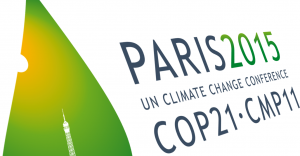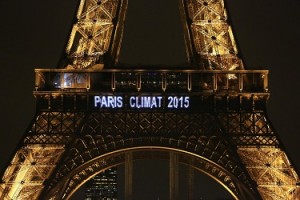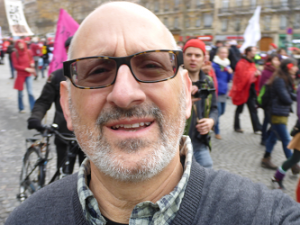 Peter Zahn, U.S. Green Chamber’s Co-Founder and founding Chair, sent out this update from Paris just before 195 countries signed the first ever global agreement to eliminate fossil fuels and transition to 100% renewable energy.
Peter Zahn, U.S. Green Chamber’s Co-Founder and founding Chair, sent out this update from Paris just before 195 countries signed the first ever global agreement to eliminate fossil fuels and transition to 100% renewable energy.
“Peter’s insight into this historic United Nation’s Climate session was a frank and honest account—covering a play by play of the challenges, the coalitions and the funding proposals ” said Michelle Thatcher, CEO of U.S. Green Chamber. “Through his personal story, he takes us all to Paris and shows us the good, the bad and the hopeful.”
 Letter from Peter Zahn, Founding USGCC Chair and Co-Founder. 12/11/15 Paris:
Letter from Peter Zahn, Founding USGCC Chair and Co-Founder. 12/11/15 Paris:
I’m attending the U.N. Climate Sessions in Paris (also called “COP21”) and want to share some observations. Despite the news media’s focus on the latest terror attacks, Republican candidates and the budget showdown, history will probably be made here in the next 24 – 48 hours. The countries have been negotiating how to contain global temperature rise (measured from pre-industrial revolution) to no more than 2 degrees celsius (3.7 deg F). And how to help the developing nations with the costs of mitigating and adapting to the effects of climate change.
Things started off well. Before I got here, 145 heads of state – including President Obama – came to get the conference started. Their showing is a record for any global meeting. Each participating country – all 187 of them – supplied specific targets for carbon emission reductions. What’s amazing is just about every nation is taking climate change seriously, with a level of commitment that dwarfs every previous climate gathering, including Copenhagen and Kyoto.
Over the last 5 days I’ve been attached to the Natural Resources Defense Council (NRDC) delegation and spent time with members of the California state delegation; represented the City of Solana Beach, California at city and regional government gatherings; and attended meetings and events with foundations, financiers, scientists, corporations, indigenous peoples, the Environmental Defense Fund and other NGO’s, Senators, foreign ministers, climatologists, lobbyists, ocean and forestry experts, a White House climate change policy advisor, and the UK’s Special Climate Representative.
Key Issues in the Home Stretch. The final agreement is supposed to be finished tomorrow. For those who can stomach some dry reading, here are the main open issues – these will continue to be discussed well after a final agreement is reached:
1. Is the 2 degrees C maximum temperature rise adequate, or should the parties agree to a 1.5 degree target? A 1.5 degree cap on temperature rise has been pushed by the poorer developing countries and is gaining traction, at least as an aspiration for future global target.
2. Should the parties reconvene within 5 years to make pledges for more aggressive carbon reductions? Especially since many countries probably low-balled their emissions targets and could do better than they claim. NRDC would like all of the countries to come together in 5 years, and review each country’s pledge for further emission reductions; China says that’s too soon, since they do planning in 5 year chunks and need time to review and make decisions on their successive plans). Also China wants the targets to be considered as a single global block, rather than a review of each country’s target.
3. Should there be regular reporting against each country’s emission targets? Since this agreement will not be truly binding (we know that Obama could not get our congress to ratify it), some have suggested that in addition to detailed reporting, an expert body should review the actual emissions against each country’s targets. Should an expert body review this reporting and express an opinion? Should this be done in a public session? (China and India are not happy with these ideas).
4. How will the funds committed by the developing countries (the Green Fund) actually come together? Which countries are eligible for assistance to combat the effects of climate change? The developing nations have already committed about $65 Billion out of a desired $100B initial fund). China and India would like transparency by the developing nations in reporting their contributions; however China and India also argue that they are still “developing countries.” Most agree that by 2030 they can no longer make that assertion.
 Interesting coalitions of nations have formed to increase negotiating power. For example, the High Ambition Coalition (gotta love that name!) consists of countries that want an agreement that is aggressive in impact. This includes the European nations, the small island countries, and some African countries; the USA recently joined. This puts pressure on China/India because developing countries are pushing hard, along with African countries that China has been courting aggressively for business opportunities.
Interesting coalitions of nations have formed to increase negotiating power. For example, the High Ambition Coalition (gotta love that name!) consists of countries that want an agreement that is aggressive in impact. This includes the European nations, the small island countries, and some African countries; the USA recently joined. This puts pressure on China/India because developing countries are pushing hard, along with African countries that China has been courting aggressively for business opportunities.
Not to be outdone, a counter coalition, the “Like Minded Group,” consists of countries like Saudi Arabia, Malaysia, Venezuela, and Bolivia, as well as China and India. You might call this group the trouble makers.
That said, despite negative comments about China and India, they have made commitments that will transform their economies and greatly contribute to reductions in carbon emissions. We just need to hold them to their plans.
Bottom Line: A Fundamental Shift is Coming. Despite the differences between the countries, and regardless of what the final agreement says, this conference will send a strong signal to the market and unleash massive investments in a new clean energy economy. And regulators will face pressures to remove protections enjoyed by the fossil fuel industry.
Camped out in the most vibrant, wonderful city in the world, the time and mood are right for an agreement. Regardless, I am out of here Sunday!
Follow Up Comment on December 13, 2015
The agreement that was finalized was as good as we could expect, given that all the countries had to agree, and any one country could kill the whole thing. The parties achieved middle ground on many of the key issues. The climate revolution has begun!
All the best,
Peter







